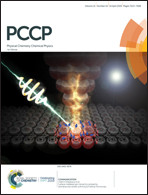The effect of Fe vacancies and Cu adhesion on the magnetic properties of Fe3GeTe2†
Abstract
Fe3GeTe2 is a promising two-dimensional magnetic material that exhibits a high Curie temperature with monolayer geometry. Using the first principles calculation method, the effects of both Fe vacancies and contact with Cu electrodes on the magnetic properties of Fe3GeTe2 are studied. Calculation results determined that Fe vacancies occur preferentially on the FeII site. As a result, the magnetic moment of FeI ions decreases significantly, while the magnetic moment of FeII increases due to the presence of the FeII vacancies. The Cu(111) layers that act as the electrodes have moderately strong bonds with Fe3GeTe2 but they are found not to distort the primary structure of the Fe3GeTe2 monolayers, thus producing a stable Cu(111)/Fe3GeTe2 interface. The magnetic moments of FeI atoms at the Fe3GeTe2 layer surface decrease substantially following the adhesion of Cu(111) layers. The effect for other Fe atoms, however, is relatively weak. These results are useful for experimental studies and can promote the applications of Fe3GeTe2 in spin electronics.



 Please wait while we load your content...
Please wait while we load your content...